Mealybugs always spread from plant to plant. So, they must come into your garden from any infested plant that you bought from a nursery.
They are like small white fuzzy bugs on your plants and they are soft-bodied with a white powdery coat on them.
Overwatering and over usage of nitrogen-rich fertilizers are other reasons for attracting mealybugs to your garden.
How can I get rid of mealybugs: Use 70% rubbing alcohol, apply neem oil to kill mealybugs, water blast and brushing, homemade spray solutions with soap water, baking soda, vinegar, etc., and introduced natural predators like ladybugs to keep mealybugs at bay.
Scroll down for detailed ideas on where do mealybugs come from, how they spread, what does it look like, and how to prevent infection on succulents.
Can mealybugs infestation go away on its own and can plants recover?
No, the small fuzzy bugs infestation won’t go off your garden on its own and plants can’t fight back. Unless there is a wave of ladybugs reaching your garden to entirely munch and wipe the mealybugs off.
Your plant needs your assistance to clear the mealybugs and can recover in a week under proper care for light, water, and feed.
What can kill these mealybugs almost instantly? You can use 70% isopropyl alcohol to dab to spray on infested spots to dissolve them and kill these white bugs fast.
Should I throw my plant away if infested?
Unless it’s not cared for long and is heavily infested with these small white bugs, you don’t have to throw and you have a second chance. If the entire plant is covered with small white and fuzzy-looking bugs, firstly isolate and do water blast and care. If it doesn’t recover, discard that plant as a last resort to prevent further spread. These mealybugs are masters of survival and can even live for 20+ days without a host.
Related: How to get rid of spidermites
How Can I Get Rid of Mealybugs
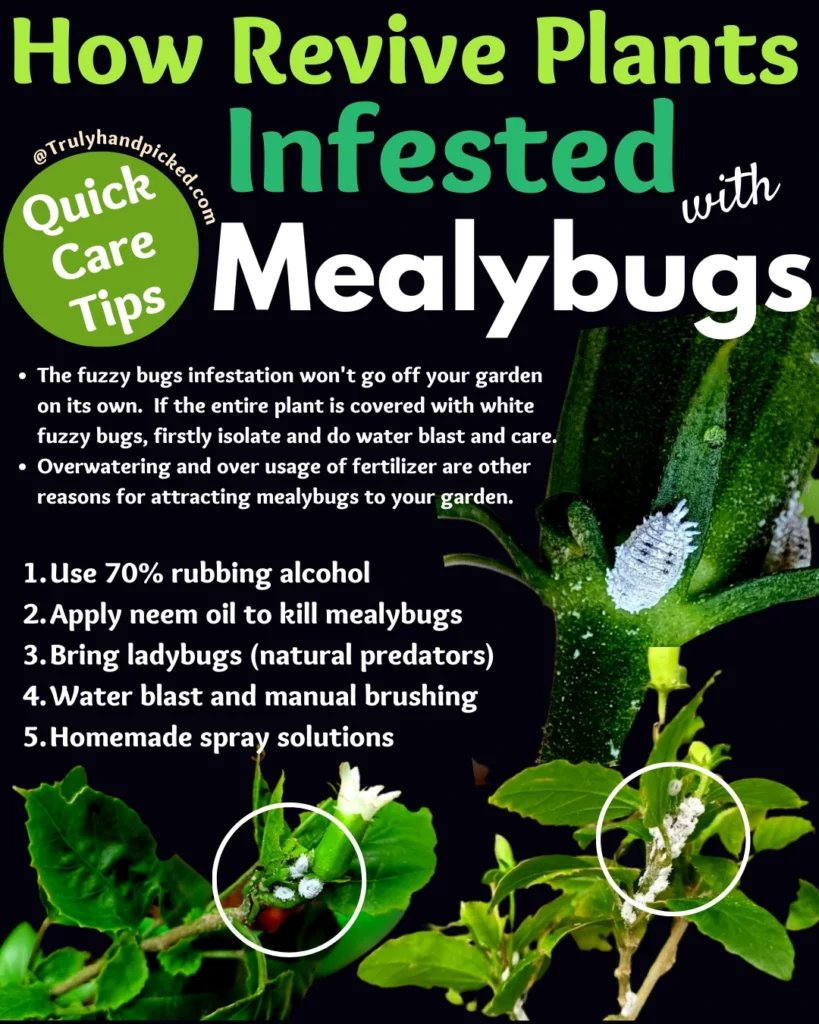
1. Use 70% Rubbing Alcohol:
To get rid of the grasp of mealybugs from your plants, use rubbing alcohol. It is one of the most effective and promising home remedies. The application steps are as follows-
- Take some 70% isopropyl alcohol in a tiny bowl and dip a cotton ball into it.
- Now, rub that cotton ball on the infected part of your plant deeply and let the alcohol do the rest work of removing them.
- You can also spray a layer of rubbing alcohol on the stem, leaves, and bottom side with a spray bottle on the mealybugs-infested plants. Mix one part of rubbing alcohol with 7 parts of water in the spray bottle.
- Repeat this process one to two times a week until the mealybugs are gone completely.
2. Apply Neem Oil to Kill Mealybugs:
Neem oil is another brilliant insecticide to use for removing the spread of mealybugs from your favorite garden plants. To apply this product-
- Take an empty spray bottle and 500 to 700ml plain water into it.
- Add 1-2 teaspoons of raw neem oil into the water along with 1 tbsp of mild liquid soap.
- Set the lid and shake the bottle finely until you combine the inside mixture properly.
- Now, use this mixture to spray until it reaches each part of your infested plant properly.
- Now keep the planter in a shady or partially shady windowsill and repeat this process weekly until the mealybugs are gone permanently.
- Also, keep in mind this won’t work like magic, it will 3 to 4 applications before it could wipe the bug’s colony.
Note before using neem oil or rubbing alcohol on your plants move them to the shade and let it be there for a few days after spraying.
Related: How to get rid of thrips on your plants
3. Water Blast and Brushing for Upperhand
If your plant can tolerate a steady stream of water, you could rinse off the mealybugs. Though it won’t help you totally get rid of these bugs, it will definitely remove the majority of them.
If it is a small succulent or plant you can also use a medium to soft brush to brush off the mealybugs to some extent to prevent further infection.
Before doing any of this, isolate the plant/succulent from other plants to prevent further spread.
Related: How to get rid of aphids
4. Homemade Sprays for Mealybugs:
Some other useful and simple homemade sprays to control the spread of these white bugs and kill them are-
- Soapy water spray that is made with 1 tsp insecticidal soap in 1 liter of water
- A mixture of baking soda and water
- A mixture of apple cider vinegar and water in a 1:2 ratio
- And a mixture of water and some essential oils like tea tree oil, spearmint oil, eucalyptus oil, peppermint oil, etc. Like 1 tsp of eucalyptus oil with a few drops of soap and 2 cups of water in a spray bottle.
Related: Best plants to get rid of flies
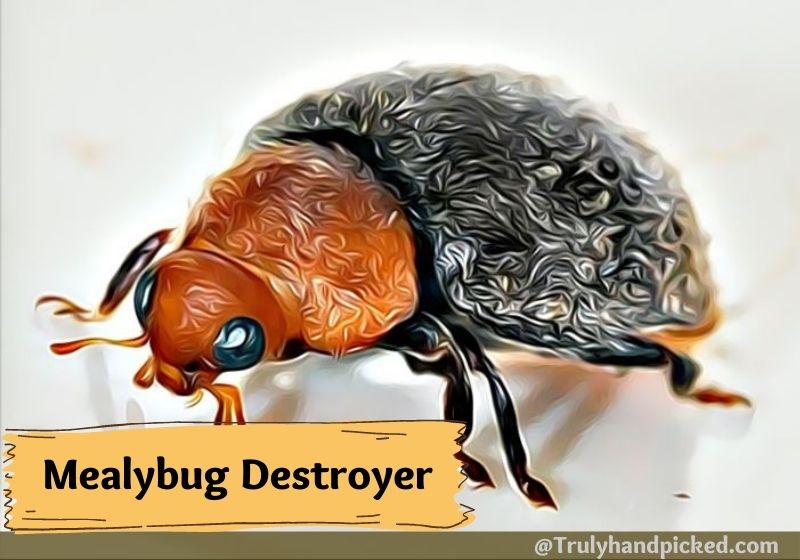
5. Introduce Predator: What is Mealybug Destroyer?
Cryptolaemus montrouzieri bug is known as a mealybug destroyer (ladybugs). While this bug belongs to the ladybug species (dark without any spots) but it is confused with mealybugs during its initial stages.
This beetle is a predator of mealybugs and thus, can clean up the spreading of mealybugs easily out of your infested garden plants.
Related: How to get rid of fungus gnats
How to Treat Mealybugs Infestation on My Succulents
- Firstly quarantine the infected plant
- Rinse the plant until the cottony-looking bugs are visibly clear off your succulent
- Use a strong stream of water that your succulent or plant can handle
- Use rubbing alcohol and cotton Qtip to further remove visible mealybugs and nests.
- Thoroughly wash your pot and also look for nooks. As they are masters in survival without a host, even for weeks together.
- Sterilize the soil to be used later or throw it away.
- Let the pot and plant get dry for sometime
- Later add the new potting mix for succulents and repot the little one.
- Spray safe repellents like mild dish soap water or rubbing alcohol to prevent infection.
- If you feel your succulent is sensitive, test on a few leaves before going for a full spray.
- Avoid sunlight for a few days.
- Once set, check your succulent for a few days for any new infections to wipe them out. This will keep your plant happy and permanently safe from mealybugs.
Related: How to get rid of slugs from your garden
How to Get Rid of Mealybugs in Soil:
To remove the spread of these small white bugs in the soil, spraying acephate or malathion is the best method. To apply this remedy, follow these steps-
- Take 1 tbsp of Malathion 50 or any acephate in a spray bottle filled with 4 liters of water
- Now, spray this mixture over the outer surface of the soil after shaking the bottle a couple of times
- Spray this mixture often for 3-4 months over the infected area and you can clean the soil out of the grasp of mealybugs completely.
If your potting soil is completely infested sterilize it. And let be idle for days before using it for a plant or completely trashing it.

Lifecycle of Mealy Bugs
- Adult female mealybugs lay hundreds of eggs in a safe white cotton-like waxy nest.
- Later they develop into nymphs female crawlers and males in two weeks
- Males are short-lived and don’t directly hurt your plant.
- While female bugs are tiny white crawlers, that slowly move across the plant to feed and grow vigorously.
- In 2 months’ time, all these fuzzy crawlers grow stages to become fully grown mealybugs.
- Within a year, you could witness (if possible) generations of mealy bugs
- While male bugs are tiny, winged, and rarely seen.
Related: How to keep cats away
Mealybugs are one common type of insect, which gather and feed on the sap of plants. Mealybugs may appear tiny and unharmful but can cause serious damage to your garden plants, as they always come in a cluster.
They can make your plants wilt, go dry, and a few species inject toxins while they feed on your plants. And if left unnoticed most of your plants could get infected and lose leaves and die.
Normal pesticides might save your plants from mealybugs, but they will cause other mutilations too. Thus, here we come up with some side effect-free home remedies to treat mealybugs, let’s learn those tricks quickly below-
What Do Mealybugs Look Like?
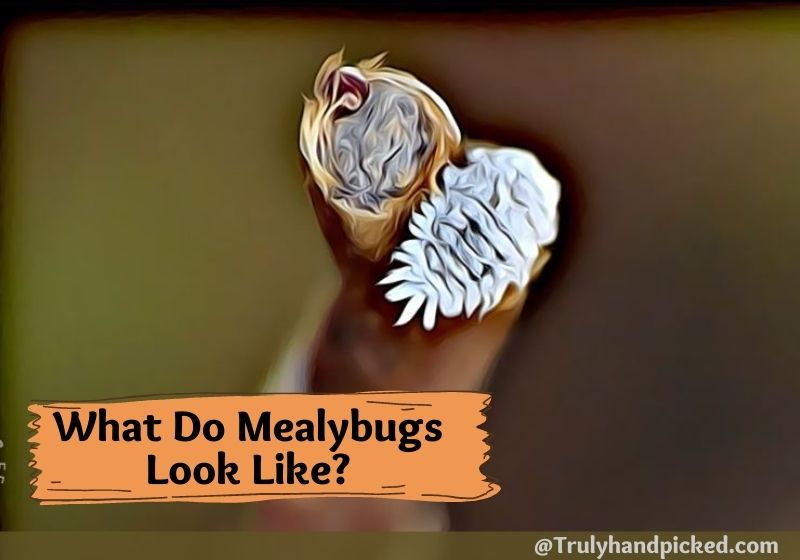
Mealybugs are like small white fuzzy bugs on your plants and they are soft-bodied with a white powdery coat on them.
Most of the species of mealybugs appear with this tiny white ambiguous figure and people confuse it with fungus as these bugs don’t make any visible movement on your plants.
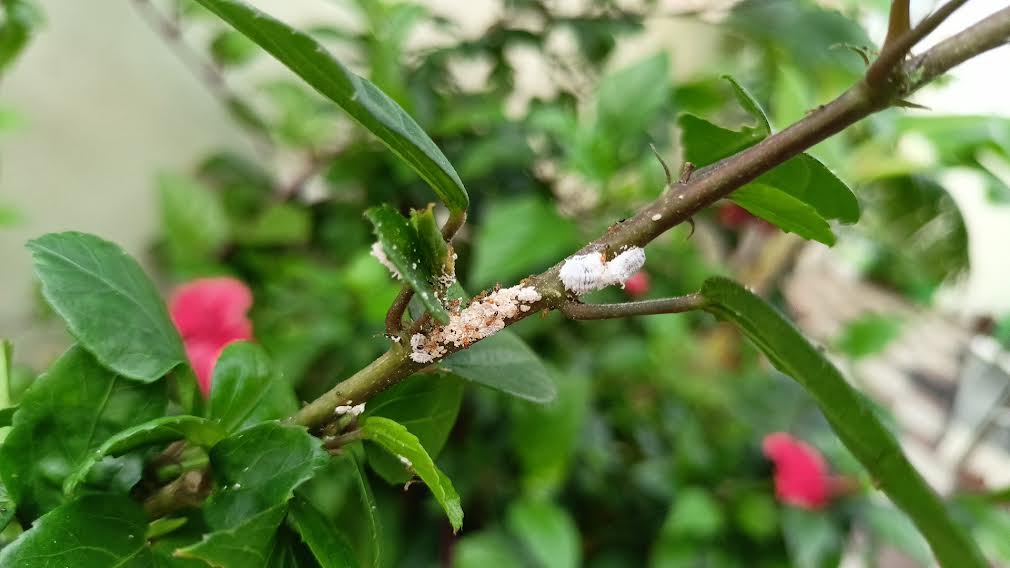
However, some of them have long, tail-like filaments at the rear ends of their torso. These filaments look like the tiny tail of these small-scale insects.
- Size: These little bugs range from 1mm to 5mm max in size
- Color: Soft pinkish body covered with a white powdery coat.
- Mealybug eggs: Also, you could notice white fungus-like white cottony mass egg sacs where the female bugs lay hundreds of pinkish or yellow-colored eggs.
- Infestation identification: An infested plant looks like white fluffy cotton patches on your plant and leaves.
They always appear in a group, crawling on the sap, leaves, and stems of normal garden plants. Mealybugs form small white nests where they feed, with a waxy coating resemblance. Thus sometimes, they resemble a layer of sprinkled snow or cotton-like web on the sap of your plants.
Where do Mealybugs Come from and how do they spread:
Mealybugs always spread from plant to plant. So, they must come into your garden from any infested plant that you bought from a nursery.
They can even live in the soil for 2 to 4 months starting from plant sap. Thus, you can sometimes find that your garden plants are infested by mealybugs from the soil too.
Now, soil can bring mealybugs from outside of your house through the leaves of an infested plant. Mealybugs mostly spread through an infested plant from a nursery or greenhouse.
Also, natural carriers like wind, rain, birds, ants and we humans unknowingly carry and help them spread from one place or plant to another.
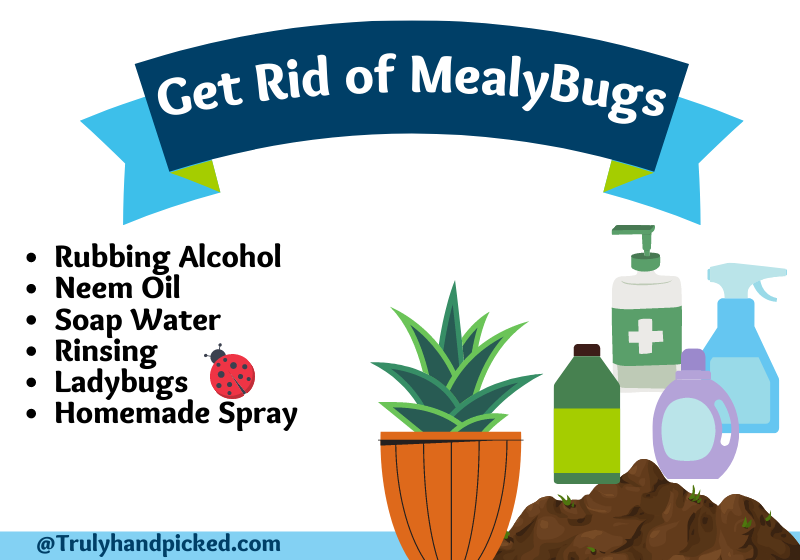
How Mealybugs are Harmful to Plants:
Mealybugs can be extremely damageable to your garden plants if they remain untreated for a long. Some of the typical harmful effects, mealybugs can produce on your plants, are-
- They feed themselves by sucking the plant juice from stems and leaves
- This will hamper the growth of your growing plants badly
- A consistent period of mealybugs on plants can make the leaf yellow, wilt, and drop leaf as well
- Mealybugs also produce a gluey substance honeydew that escalates the mold growth on your plants
- Sometimes, even mealybugs can kill your garden plant, if you don’t apply any remedy to them soon.
Why My Garden is Often Infested by Mealybugs?
In short: Overfertilizing and over-watering will harm your plants’ growth and increased nitrogen levels will attract and make way for these bugs to persist in your garden.
Your garden plants may get infested by mealybugs for a couple of reasons, let’s see what causes mealybugs infestation–
- Mealybugs are attracted to rich sap content and plants like hibiscus, fruiting plants, and succulents too
- Tropical climate
- Getting an infested plant into your garden from a nursery
- Garden soil has mealybugs infestation before planting
- Too much usage of nitrogen-based fertilizer
- Overwatering your garden plants
- Houseplants placed outside in the scorching heat of summer
How to Prevent Mealybugs from Spreading:
Some smart moves can save you and your garden plants from getting infested by mealybugs. Such as
- Keep a close look at the sap of your plants regularly for the first appearance of mealybugs.
- Often check for your plant’s stem tips.
- Prune any mealybugs-infested leaf or stem instantly, once you find them on a plant.
- Apply insecticides on your garden plants with a good amount of alcoholic substances.
- Apply a home remedy as soon as possible, once you realize that any of your garden plants has a mealybugs infestation.
- Avoid often usage of nitrogen-rich fertilizers.
- And bring sterilized garden tools as well as a planter, after cleaning up the infestation of mealybugs from your garden.
FAQ: Mealybugs Quick Summary
Q: Can Mealybugs Jump or Fly?
Mealybugs neither jump nor fly. Male bugs have wings, but they are rarely seen and also short-lived. Only the nymphs crawl only from one plant to another.
Q: Are Mealybugs Harmful to Humans?
These tiny white fuzzy bugs could not bite or provide any sort of serious harm to humans. But by sucking the sap from your plants, making ovisacs and honeydew they slowly kill your plants. If that hurts your heart, then surely mealybugs are harmful to humans :).
Q: Baking Soda/ Hydroperoxide/ Vinegar for Mealybugs:
Baking soda and vinegar are two useful things to control and kill the spread of mealybugs on your plants. However, hydroperoxide could not help that much in this attempt.
Q: How do I use Neem Oil to get rid of mealybugs?
To use Neem Oil to get rid of mealybugs, mix 1 teaspoon of Neem Oil in 1 quart of water and spray liberally on the affected plants. Repeat this process every two weeks until the mealybugs are gone.
Q: How do I use rubbing alcohol to get rid of mealybugs?
To use rubbing alcohol to get rid of mealybugs, mix 1 part rubbing alcohol and 1 part water in a spray bottle. Spray the affected plants liberally and repeat the process every few days until the mealybugs are gone.
Q: How can I permanently get rid of mealybugs?
To permanently get rid of mealybugs, combine physical removal (such as wiping them off the plants with a damp cloth) with natural treatments such as Neem Oil and soapy water. Additionally, introduce beneficial insects such as ladybugs to the area, as they will feed on mealybugs.
Q: How do I use soapy water to get rid of mealybugs?
Use soapy water to get rid of mealybugs, mix 1 teaspoon of mild dish soap (such as Dawn) in 1 quart of water and spray liberally on the affected plants. Repeat this process every two weeks until the mealybugs are gone.
Q: How do I kill mealybugs in soil?
Use beneficial nematodes that will feed on mealybugs. Additionally, you can use a combination of physical removal and natural treatments such as Neem Oil and soapy water.
Q: How do I spray for mealybugs?
Mix 1 teaspoon of Neem Oil or mild dish soap (such as Dawn) in 1 quart of water and spray liberally on the affected plants. Repeat this process every two weeks until the mealybugs are gone.
Q: What are the reasons for mealybugs?
The reasons for mealybugs include high humidity levels, lack of air circulation, and over-fertilization. Additionally, mealybugs can be introduced to the area on plants from other locations.
Q: What are mealybugs?
A: Mealybugs are small, soft-bodied insects, usually measuring about 2-4 millimeters in length, that feed on plant sap. They have a white, waxy coating, which gives them a “mealy” look. Mealybugs are commonly found on plants in warm, humid environments.
Q: How do I know if my plants have mealybugs?
A: If you notice white, cottony masses on the stems or leaves of your plants, it is likely that they are infested with mealybugs. You may also see small, yellowish spots on the leaves, which are the mealybugs’ excrement.
Q: How do I get rid of mealybugs?
A: Mealybugs can be difficult to get rid of, but there are a few methods you can try. The first is to physically remove them by hand, using a cotton swab or a toothpick. You can also use insecticidal soap or neem oil to kill them. Finally, you can introduce beneficial insects to your plants, such as ladybugs and lacewings, which will feed on the mealybugs and help keep the population under control.